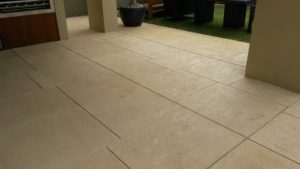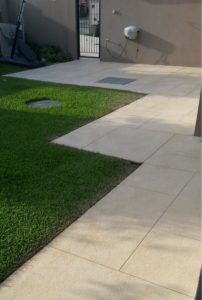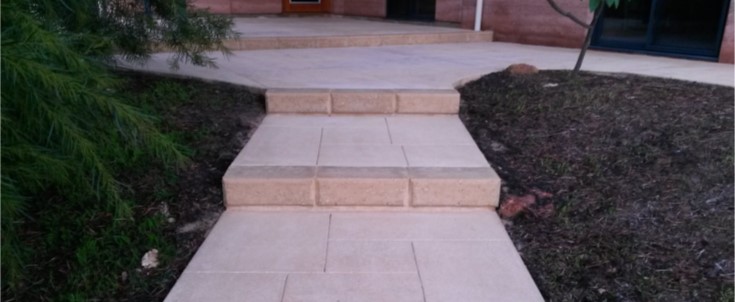Caring for your Liquid Limestone
 Liquid limestone is a very popular pavement option in Western Australia. It is made by mixing cement with crushed limestone. It provides a nice stable flooring that is cool underfoot. It has a natural character that is hard to replicate with concrete while still possessing many of the advantages of concrete. It is impervious to ants and weeds, and can be formed into almost shape to provide seamless flow throughout even the most unconventional backyards. It does however possess a few characteristics that, if not considered, may leave you with a less than complimentary opinion on this great product.
Liquid limestone is a very popular pavement option in Western Australia. It is made by mixing cement with crushed limestone. It provides a nice stable flooring that is cool underfoot. It has a natural character that is hard to replicate with concrete while still possessing many of the advantages of concrete. It is impervious to ants and weeds, and can be formed into almost shape to provide seamless flow throughout even the most unconventional backyards. It does however possess a few characteristics that, if not considered, may leave you with a less than complimentary opinion on this great product.
Liquid Limestone is Soft
Natural limestone varies significantly in hardness depending on how it is formed. Travertine is a very hard form of limestone that is formed by mineral deposition over a long period of time (think stalagmites and stalactites). The limestone used for liquid limestone on the other hand is from sedimentary rock and this is nowhere near as dense. Crushed limestone is far from the toughest rock on the block. It crumbles relatively easily, which is great if you want something that will compact nicely for the base of a road, but not so great if you want to build a structure that will endure the elements and stand the test of time.
The strength in the liquid limestone comes primarily from the cement. It is the glue that holds these crumbly rocks together. Once the limestone aggregate is locked into position by the cement it has a much higher compressive strength (MPa) because there is reduced lateral shear (it can’t bust out sideways). Different types and grades of cement will give different strength liquid limestone. The stronger the glue, the stronger and more durable the final product will be. Unfortunately, liquid limestone strengths are not regulated like concrete. This is because it is not classed as a structural product. This can make it very difficult to figure out if you are getting a quality product.
If you haven’t had your limestone poured yet discuss the mix strength with your contractor to ensure you get the best possible durability. Penetrating sealers will soak in and stabilise the surfaces of the pavers, while film forming sealers will provide a protective layer on the surface to prevent erosion. Pro Seal 896 is ideal for liquid limestone as it penetrates deep into the limestone to stabilise the substrate while also forming a surface film to protect against wear and the elements.
For more information, see our limestone cleaning and sealing service page.
Liquid Limestone is Porous
 Liquid limestone is very porous and as such the requirement for a good quality sealer cannot be overstated. If left unprotected the pores in the limestone soak up spills quickly and, as such, stains develop almost immediately. The pores also provide lots of tiny voids were algae and bacteria can gain a footing and begin to multiply. Bacteria, algae and mold spores send down tiny roots into these pores causing microscopic fractures that lead to increased weathering and erosion.
Liquid limestone is very porous and as such the requirement for a good quality sealer cannot be overstated. If left unprotected the pores in the limestone soak up spills quickly and, as such, stains develop almost immediately. The pores also provide lots of tiny voids were algae and bacteria can gain a footing and begin to multiply. Bacteria, algae and mold spores send down tiny roots into these pores causing microscopic fractures that lead to increased weathering and erosion.
All porous substances can also suffer from rising damp but given the high porosity of limestone it is particularly susceptible. Rising damp is when moisture from the ground rises up through the substrate. This can create problems such as efflorescence, mold and mildew. It can also lead to delamination of film forming sealers. Rising damp is prevalent in low lying areas and in pavement adjacent to pools, lawn and garden beds. Raised garden beds are particularly detrimental as they can create positive hydrostatic pressure in the ground around them.
If the limestone has not yet been poured, make sure a membrane (black plastic) is used underneath and that plenty of drainage has been included with good falls to ensure all water drains away. When sealing, use a breathable sealer such as Pro Seal 896 to ensure any moisture that does find its way into the slab can escape without causing to many problems.
Click here to get an instant online quote to seal your liquid limestone
Liquid Limestone Reflects Light
The pale colour of limestone reflects most of the sun’s rays and is the main reason why it stays nice and cool. Reflected light can be very beneficial and can help to get some light into darker areas such as alfresco and shaded garden areas. It does however compound a very common issue with liquid limestone and that is algae growth. Algae needs water, and light to grow effectively. Algae will grow on most external surfaces but is particularly prevalent on liquid limestone as unsealed limestone retains a lot of water and there is an abundant amount of light.
Reducing the amount of light is difficult to accomplish and in many instances the preference is to retain as much natural light as possible. The best way to keep the algae in check is, therefore, to get rid of the water. To get rid of all the water you are going to need:
- consistent fall across the pavement
- drainage grates installed in any low sections
- a good quality sealer to ensure water runs off rather than soaking into the limestone
The easiest way to accomplish all this is to make sure the contractor pouring your limestone has it all included in their scope of their work. It is worth paying extra for upfront as it will save you a lot of issues down the track.
If you have an existing installation with poor drainage, there are a few things you can do to improve it. If water naturally flows towards garden beds or grassed areas dig out a channel along the edge to allow water to freely drain away. To make this neat and tidy you can install a spoon drain along these edges and plumb it off to existing storm water drains or an area in the garden where there is room to install a soak well.
If the water flows to an edge that is adjacent to a fence or wall you can cut away the edge section and get a spoon drain installed or simply dig out some sand under the cut away section and fill the void up with large pebbles.
Contractor Checklist
- Mix strength/MPa rating
- Drainage – ensure earthworks are done to create adequate falls. Pipework, spoon drains and soak wells installed prior to pour
- Use of membranes to prevent rising damp
- Reinforcing and pour thickness – galvanized reinforcing and a minimum thickness of 100mm is recommended for all liquid limestone installations
- Sealer – ensure limestone is sealed only with Pro Seal 896
Contact Mr Blastit to get your liquid limestone sealed with Pro Seal 896!
Phone 0419 350 332 or Email Us

